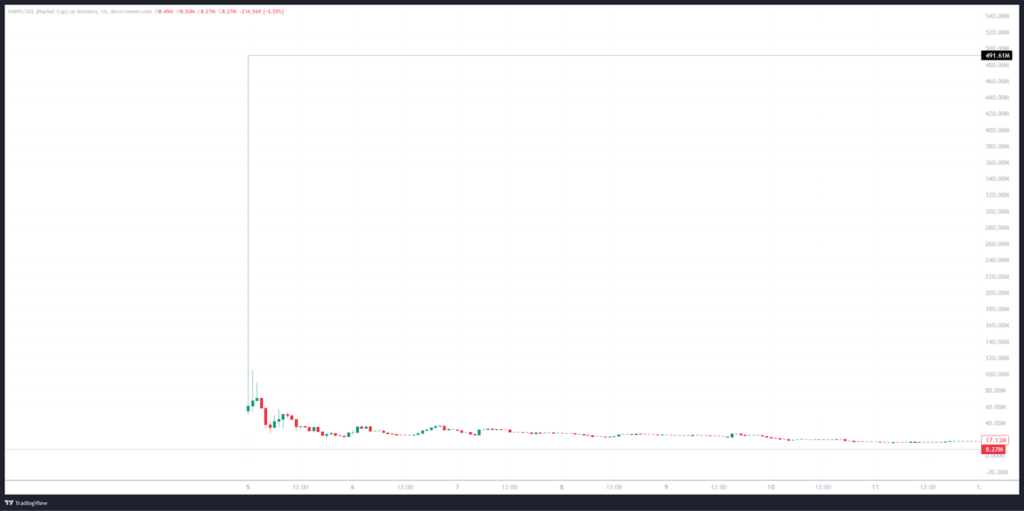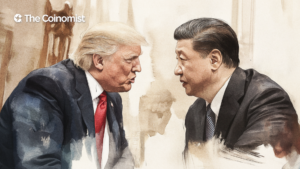From Bulls to Ballers — Why Celebrities Are Flocking to Crypto

Trump’s meme coin isn’t an outlier—it’s part of a broader trend. Back in 2021, celebrities were minting NFTs, and by 2024, they had moved on to personal token launches. The connection between fame and crypto has been growing for years, even if many failed to see it.
On this page
The rise of crypto has drawn more than just retail investors—it has also lured in celebrities from across industries. Athletes, musicians, actors, and influencers have all made forays into the Web3 space, with varying degrees of success.
Here’s how some well-known names fared:
- Matt Damon – The Good Will Hunting actor fronted Crypto.com’s Fortune Favors the Brave campaign in October 2021. Soon after, Bitcoin lost over 60% of its value.
- Mike Tyson – The boxing legend launched an NFT collection in August 2021, but its average price later dropped by more than 95%.
- Caitlyn Jenner – The reality TV star introduced the JENNER meme coin in May 2024, which peaked at $1.6 billion before crashing to just $100,000.
Crypto projects don’t just live or die by their technology—marketing makes all the difference. So when a celebrity with a million X followers launches a meme coin or endorses a crypto project, its success becomes almost inevitable.
But why does this work so well?
It’s human psychology. People trust the familiar—family, friends, colleagues. This deep-seated instinct builds confidence in their choices. Marketing exploits this by using celebrities as trust signals. We see them excel in music, sports, or film, and subconsciously assume they wouldn’t put their name on something that could fail. That assumption? It’s what makes celebrity-backed crypto projects so appealing.
Check out: How VINE Memecoin Is Transforming Marketing
The halo effect plays a powerful role in marketing, making us associate a celebrity’s personal qualities with the products they endorse. If they seem intelligent, accomplished, or likable, we instinctively assume the same about whatever they promote.
This trust strengthens even further when we believe the celebrity actually uses the product rather than simply being paid for an ad campaign.
Given this, it’s no wonder that crypto has become a magnet for famous figures. Some stick to endorsements, while others take a more hands-on approach—launching meme coins, producing educational content, or co-developing NFT projects.
The key questions remain: Are these celebrities genuinely invested in crypto, or is this just another revenue stream? What risks does this pose to investors? And how will their involvement shape the industry’s future?
Why Are Celebrities Flocking to Crypto?
The lines between entertainment and crypto are blurring, with big names from sports, film, television, and social media making waves in the industry. One moment, an actor is promoting a major exchange, the next, an athlete is launching a personal token, and influencers are rolling out blockchain masterclasses.
While financial gain is an obvious motivator, it’s not the only factor at play. Celebrities see crypto as a PR tool, a way to future-proof their careers, and an avenue for strategic partnerships. By integrating digital assets into their brands, they’re not just investing in crypto—they’re investing in cultural relevance.
Why Celebrities Can’t Resist Crypto’s High-Profit Potential
Crypto has made millionaires out of everyday users—so for celebrities with vast audiences, the opportunity is even greater. Instead of searching for the next big token, they create their own, form partnerships, or promote projects for a price.
Before labeling this a money grab, let’s take a closer look at just how much they actually earn from these ventures.
Floyd Mayweather
The mint price for Mayweather’s NFT drop was $900, with a 5,000-unit supply. If everything sold, the boxing legend pocketed $4.5 million—before accounting for costs.
Not exactly a knockout sum.
To put it in perspective, Mayweather walked away with $300 million from his high-profile showdown with Conor McGregor.

Adin Ross
Twitch streamer Adin Ross faced backlash in 2021 for promoting MILF, a token widely considered a rug pull. The entire promotion lasted just minutes during a live stream with 75,000 viewers, yet sources claim Ross made around $200,000 from the deal.
Rich the Kid
That same year, hip-hop artist Rich the Kid capitalized on the NFT trend, launching his own collection. Sales reportedly brought him $2 million.

If one thing is certain, it’s that celebrity-backed crypto ventures are almost always lucrative—for the celebrities, at least. Sure, their projects might fail, investors might take losses, and reputations might take a hit. But history shows that people tend to forget within weeks.
Curious about more celebrity crypto flops? Check out our feature: “Top 5 Celebrity Crypto Scandals.”
Leveraging Crypto for Branding and Web3 Expansion
Not every celebrity enters crypto just for financial gain. Some use it as a springboard for publicity, making appearances on shows, forming partnerships, and venturing into Web3 to capture younger audiences.
For these stars, launching a meme coin is more than just a side hustle—it’s a strategic branding move. Many sell or burn their holdings from the start to prevent accusations of market manipulation.
Consider Rus Yusupov, the mind behind Vine. In January 2025, he unveiled VINE, a meme coin inspired by his viral video platform. The results were instant—within 12 hours, its market cap exploded to $500 million, before crashing to $160,000.
Yet, Yusupov hasn’t offloaded a single token—instead, he plans to use VINE to fuel Web3 marketing campaigns.
Of interest: Teen Millionaires? The Risks and Rewards of Young Investors
The Role of Celebrities in Web3 Adoption
For some, crypto is a means to wealth. For others, it’s a mission—a belief in blockchain’s power to disrupt industries and create financial independence. These advocates aren’t always developers or hardcore traders. Sometimes, they’re just regular people or celebrities with the reach to spark conversations that matter.
Unlike traditional crypto endorsements that push exchanges or tokens, these public figures speak about crypto candidly and without a sales pitch. By sharing their genuine experiences, they help introduce blockchain to the world—not as an investment, but as a cultural shift.
The Many Ways Celebrities Are Shaping Crypto
- Brand Endorsements
Celebrity-backed crypto campaigns enhance credibility, boost public trust, and drive mass adoption. Major partnerships include Lionel Messi x Bitget, Matt Damon x Crypto.com, and Tom Brady x FTX.
- Investing in Web3 Ventures
Rather than just promoting crypto projects, some celebrities invest directly in blockchain startups. One notable example is Ashton Kutcher, who, through Sound Ventures, has supported Ripple (XRP).
- NFT Hype & Adoption
The rise of NFTs in 2021 was significantly driven by celebrity influence. Figures like Snoop Dogg, Rich the Kid, and Shaquille O’Neal embraced the trend, drawing mainstream attention to the technology.
- The Meme Coin Phenomenon
Celebrity-backed meme coins have become so popular that they now form their own niche. In the past year, stars such as Caitlyn Jenner (JENNER), Iggy Azalea (MOTHER), and Andrew Tate (DADDY) have launched their own tokens.
In crypto, trends come and go, but celebrity involvement remains a constant.
When marketing campaigns became less effective, NFTs filled the gap. When the NFT craze cooled, meme coins took over. If celebrity tokens lose their appeal, the industry will undoubtedly discover a new monetization model for high-profile figures.
When Celebrity Influence Turns Toxic—The Dark Side of Crypto Hype
Celebrity-backed crypto projects can drive massive adoption—but they can also lead to disastrous financial losses. Many influencers, focused solely on profits, endorse or launch highly speculative projects that end up hurting retail investors.
Meme coins are a prime example. A-listers pump up their audience, sending token prices soaring—only to dump their holdings once they’ve made a fortune. What’s left? A worthless token and thousands of investors left holding the bag.
This is the textbook “Pump & Dump” strategy—where early insiders cash out at the peak, while the general public bears the financial damage.

When investors get burned, trust in crypto plummets. Many begin to see the industry as a never-ending cycle of deception, prompting tighter regulatory oversight to limit celebrity influence on financial decisions.
Regulators have already taken action—Kim Kardashian was fined for promoting a crypto asset without proper disclosure.
Although a few celebrities might be genuinely invested in their meme coins, these cases are rare. In most instances, marketing agencies run the show, with stars lending their names for branding purposes.
One of the biggest players in this space is Sahil Arora, who not only deceived retail investors but even the celebrities he worked with. Blockchain investigator ZachXBT estimates that Arora earned $2–3 million last year, setting up celebrity meme coin launches.
Are сelebrity сoins worth the risk?
Before investing in a celebrity-backed token, ask yourself: Is this person truly invested in the project, or are they just cashing in on the hype? Do they have a track record of successful ventures, or is this just a quick way to make a profit?
The crypto community remains skeptical, and for good reason—most celebrity meme coins end in losses for investors. To protect yourself, always conduct thorough research and don’t blindly trust a famous name.
And if your favorite influencer suddenly launches a token, don’t be shocked if, by the next day, they claim their account was hacked and they had no involvement.
The content on The Coinomist is for informational purposes only and should not be interpreted as financial advice. While we strive to provide accurate and up-to-date information, we do not guarantee the accuracy, completeness, or reliability of any content. Neither we accept liability for any errors or omissions in the information provided or for any financial losses incurred as a result of relying on this information. Actions based on this content are at your own risk. Always do your own research and consult a professional. See our Terms, Privacy Policy, and Disclaimers for more details.


























